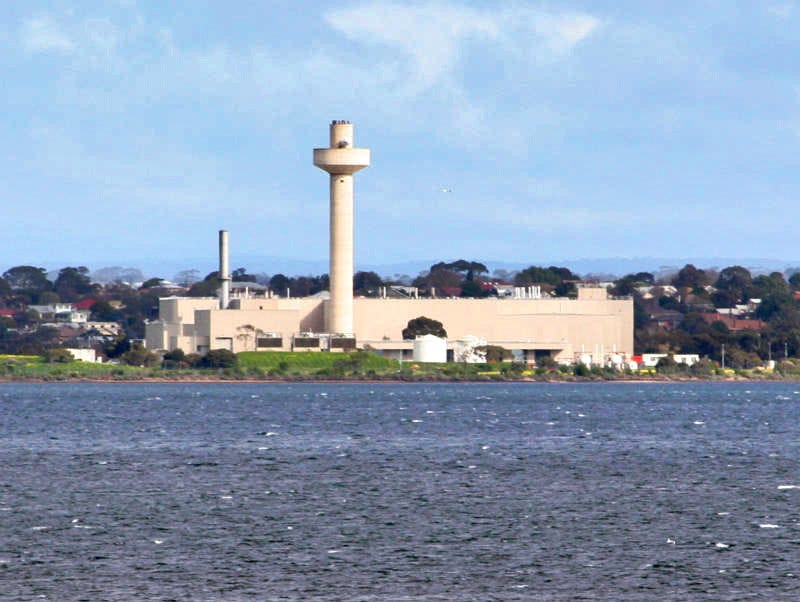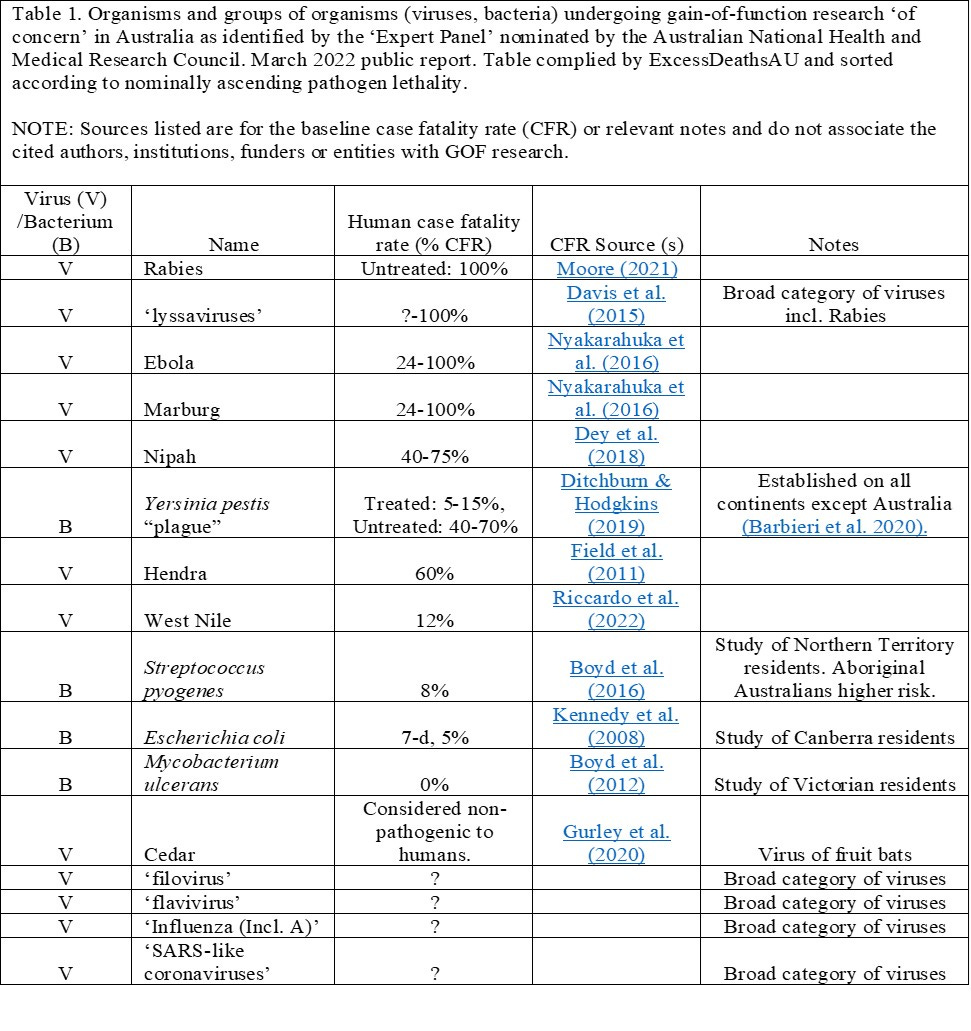Australia’s gain-of-function research as reported by the NHMRC in 2022.
Vaccines "exempt from control."

Welcome article for new readers.
ExcessDeathsAU has been banned from social media: I rely on you to share articles
Edit February 2025: Article was originally published in 2023 (as per date above). Has been updated to reflect new understanding upon the work and death of Dr Francis Boyle who assisted in an unofficial capacity. Article re-released as part of a memorial article to Dr Boyle.
Please do not live your life in fear of ‘pandemics.’ Fear is a bad master.
EDAU
The report - in their words.
In March 2022 Australia’s National Health and Medical Research Council (NHMRC) published a report (Wayback Machine) identifying gain-of-function (GOF) research programs ‘of concern’ in Australia. The following information is publicly available and directly from the report. According to the report, GOF research ‘of concern’ specifically refers to the ‘modification of viruses and bacteria to increase their risk to humans or increase pandemic potential.’
According to the report’s ‘Expert Panel,’ (their identities are never revealed) GOF research may:
Enhance production of the infectious agent.
Enhance morbidity and mortality.
Enhance transmissibility and host susceptibility.
Evade existing natural or induced immunity.
Enhance resistance to drugs or evasion of other medical countermeasures such as vaccines, therapeutics or diagnostics.
Over the last 10 years, the Australian Government has funded or conducted 17 research projects that were identified by the Expert Panel as gain-of-function research ‘of particular concern.’ Ten of the projects were funded by NHMRC and 8 were conducted by the Commonwealth Scientific and Industrial Research Organisation (CSIRO); one project was both funded by NHMRC and conducted by CSIRO.
According to the report, thirteen projects involved virological studies and four involved bacteriological studies (Table 1 - references listed below). Thirteen projects involved the use of live animals (mouse, ferret), while ‘some other’ projects involved the use of animal tissue/cell lines (e.g., bat tissue, avian cells). Three projects involved the use of human tissues. Four projects did not involve the use of either an animal model or human tissues. Thirteen projects involved the use of genetically-modified organisms (GMOs) within Australia and one project involved the use of GMOs in countries outside of Australia (Canada, USA).
According to the report, all the organisms or groups of organisms, in Table 1 are (or have been) “modified in ways that increase their risk to humans or create a potential pandemic on mainland Australia or with Australian researchers overseas.”
The ‘anticipated benefits and outcomes’ of the GOF include (but were not limited to):
Forecasting ‘flu’ and developing new ‘flu’ drugs.
Understanding the evolution of avian influenza from a low pathogenic virus to a highly pathogenic variant.
Detecting swine-flu.
Identification, transmission and virulence of flaviviruses.
Creation of a ‘laboratory mouse’ to study transmission of lyssavirus from bats to humans and vaccine protection.
Vaccines and therapeutics to Cedar, Ebola, Hendra, Marburg, Nipah viruses.
Mechanisms of cross-species transmission of bat viruses.
Understanding the mutations that cause virulence in an historical pandemic.
Developing treatments and vaccines by identifying how bacteria make toxins, cause disease and develop antibiotic resistance.
The Expert Panel concluded that the GOF research has had:
…significant medical innovations and benefits to human health, and outlines the strong regulatory controls in Australia that ensure research is conducted safely, ethically and responsibly…This research aimed to increase understanding and improve the detection, prevention and treatment of a range of viral and bacterial infections…world-class physical containment facilities, including CSIRO’s Australian Centre for Disease Preparedness (ACDP), which is a physical containment level 4 facility designed to allow scientific research on the most dangerous infectious agents to be performed safely…projects were monitored appropriately and there were no reported incidents.
Dual-use research and vaccines
In multiple points throughout the report, the Expert Panel praised the level of ‘controls’ in the GOF projects to ensure safety, but what are ‘controls’?
According to the report:
Controls include ethics and safety approvals (including biosafety and biosecurity) from government bodies and/or institutional committees that encompass consideration of the risks and benefits of the research.
What this means in real terms is paperwork: treaties, permits, licenses, boxes to tick, methods to follow, signatures on bits of papers in various locations in the facility. Inspections and visual monitoring of the government entities by the government entities.
Anyone who has taken the most basic occupational health and safety induction at a laboratory, university, office, factory or any other work place in Australia would be familiar with the inverted ‘hierarchy of controls’ starting with ‘eliminating the hazard’ (best response) at the top and ‘PPE’ (personal protective equipment) at the bottom of the pyramid. Running throughout the pyramid of safety control is ‘consultation and communication with stakeholders and those affected by the hazard.’ So my questions are:
Can this research be substituted by another method?
Why have the NHMRC and the researchers skipped the levels of basic control and gone straight to PPE and administrative control which are the most subject to human error and malfeasance?
Why has the public not been consulted if we want this research to occur in Australia? The report says the research is risky. Is the public is at risk of the hazard (stakeholder point 1)? We are funding the research (stakeholder point 2).
If this research is so ‘dangerous,’ why is it being allowed to occur in a suburb in Geelong (e.g., Australian Centre for Disease Preparedness (ACDP), formerly known as the Australian Animal Health Laboratory (AAHL))? Is it really dangerous or is the government up to something else in there?
Dual-use research, as defined by the report, is ‘research that is intended to provide a clear benefit, but which could easily be misapplied to do harm.’ Emphasis on easily. The above ‘controls’ the people of Australia and the world are relying on to stop these ‘lethal organisms’ (their words and research) from leaving the labs are entirely reliant on the competency and good will of the laboratory staff. Paperwork does not protect people from accidents. As anyone knows, there comes a point where you cannot legislate away accidents or ill-intent.
In my opinion, however, the most dangerous aspect of this research is likely the real reason for the GOF research: to create bioweapons disguised (or not disguised) as health-promoting vaccines.
Buried at the bottom of the report is this:
Vaccines are exempt from control if they are in a pharmaceutical formulation that is licensed by, or has marketing or clinical trial authorisation by, a regulatory authority.
It’s not clear if this means that vaccines are exempt from the controls associated with the Defence and Strategic Goods List (DSGL) as they relate to export, or Australia in general. The DSGL is part of a system of “international and national effort to stem the proliferation of conventional, chemical, biological and nuclear weapons and the systems that deliver them.”
Finally, the report states that:
…information about the projects is presented in general terms and, where appropriate, aggregated form. This approach is necessary to protect researchers from potentially serious threats to their personal and professional lives, as has been experienced by scientists around the world in the context of COVID-19.
The report not only states the main laboratory where the research is conducted, but the type of research as well as the organisms and a long list of publications. Their identities and locations are absolutely public. The only people who are truly anonymous in this process are the Expert Panel. Their affiliations and expert areas were listed, but only in an aggregate form (Table 18, NHMRC report).
But in the end, maybe it doesn’t matter. The research will likely be declared ‘safe and effective’ regardless of who is on the Expert Panel, and in an Emergency, Emergency Use Authorisation ensures there is no stopping condition for harm.
Final thoughts
All the treaties in the world do not negate the fact that, according to this report, Australia is creating bioweapons disguised as vaccines ostensibly to ‘find cures’ in an infinite problem-reaction-solution feedback loop. The politician who commissioned this, Hon Greg Hunt MP (Minister for Health and Aged Care), looked at this report and concluded “this is fine.”
A cursory search of the people involved in these programs demonstrate that they are deeply embedded in high-stakes international pharmaceuticals.
We are suffering under a ‘pandemic of experts’ driven by insatiable egos, feeding the system that has created them, further selecting for the people that will in turn prop up this system that is run on animal torture approved by morally bankrupt ‘ethics boards.’
There is only destruction at the end of this, and we are currently allowing experts to gamble with the lives of billions - not with the ‘dangerous germs’ they say are in the labs but with the injections and other weapons marketed as ‘curatives’ they are creating using these laboratory processes.
These arrogant ‘experts’ need to stop.
References (Table 1)
Barbieri, R., Signoli, M., Chevé, D., Costedoat, C., Tzortzis, S., Aboudharam, G., ... & Drancourt, M. (2020). Yersinia pestis: the natural history of plague. Clinical microbiology reviews, 34(1), e00044-19. https://doi.org/10.1128/CMR.00044-19
Boyd, S. C., Athan, E., Friedman, N. D., Hughes, A., Walton, A., Callan, P., ... & O'Brien, D. P. (2012). Epidemiology, clinical features and diagnosis of Mycobacterium ulcerans in an Australian population. Medical Journal of Australia, 196(5), 341-344. https://doi.org/10.5694/mja12.10087
Boyd, R., Patel, M., Currie, B. J., Holt, D. C., Harris, T., & Krause, V. (2016). High burden of invasive group A streptococcal disease in the Northern Territory of Australia. Epidemiology & Infection, 144(5), 1018-1027. doi:10.1017/S0950268815002010
Davis, B. M., Rall, G. F., & Schnell, M. J. (2015). Everything you always wanted to know about rabies virus (but were afraid to ask). Annual review of virology, 2(1), 451. 10.1146/annurev-virology-100114-055157
Dey, S., Roy, P., Dutta, T., Nandy, A., & Basak, S. C. (2018). Rational Design of Peptide Vaccines for the Highly Lethal Nipah and Hendra Viruses. BioRxiv, 425819. https://doi.org/10.1101/425819
Ditchburn, J. L., & Hodgkins, R. (2019). Yersinia pestis, a problem of the past and a re-emerging threat. Biosafety and Health, 1(2), 65-70. https://doi.org/10.1016/j.bsheal.2019.09.001
Field, H., de Jong, C., Melville, D., Smith, C., Smith, I., Broos, A., ... & Zeddeman, A. (2011). Hendra virus infection dynamics in Australian fruit bats. PloS one, 6(12), e28678. https://doi.org/10.1371/journal.pone.0028678
Kennedy, K. J., Roberts, J. L., & Collignon, P. J. (2008). Escherichia coli bacteraemia in Canberra: incidence and clinical features. Medical Journal of Australia, 188(4), 209-213. https://doi.org/10.5694/j.1326-5377.2008.tb01586.x
Moore, S. M. (2021). Challenges of rabies serology: defining context of interpretation. Viruses, 13(8), 1516. https://doi.org/10.3390/v13081516
Nyakarahuka, L., Kankya, C., Krontveit, R., Mayer, B., Mwiine, F. N., Lutwama, J., & Skjerve, E. (2016). How severe and prevalent are Ebola and Marburg viruses? A systematic review and meta-analysis of the case fatality rates and seroprevalence. BMC infectious diseases, 16(1), 1-14. https://doi.org/10.1186/s12879-016-2045-6
Riccardo, F., Bella, A., Monaco, F., Ferraro, F., Petrone, D., Mateo-Urdiales, A., ... & Palamara, A. T. (2022). Rapid increase in neuroinvasive West Nile virus infections in humans, Italy, July 2022. Eurosurveillance, 27(36), 2200653. https://doi.org/10.2807/1560-7917.ES.2022.27.36.2200653




